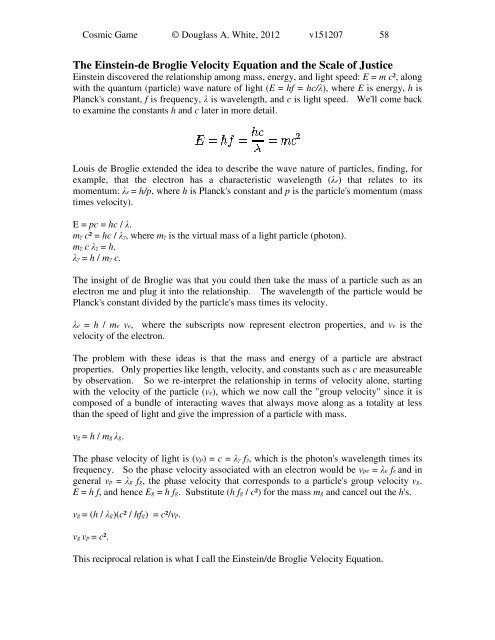Create successful ePaper yourself
Turn your PDF publications into a flip-book with our unique Google optimized e-Paper software.
<strong>Cosmic</strong> <strong>Game</strong> © Douglass A. White, 2012 v151207 58<br />
<strong>The</strong> Einstein-de Broglie Velocity Equation and the Scale of Justice<br />
Einstein discovered the relationship among mass, energy, and light speed: E = m c², along<br />
with the quantum (particle) wave nature of light (E = hf = hc/λ), where E is energy, h is<br />
Planck's constant, f is frequency, λ is wavelength, and c is light speed. We'll <strong>com</strong>e back<br />
to examine the constants h and c later in more detail.<br />
Louis de Broglie extended the idea to describe the wave nature of particles, finding, for<br />
example, that the electron has a characteristic wavelength (λe) that relates to its<br />
momentum: λe = h/p, where h is Planck's constant and p is the particle's momentum (mass<br />
times velocity).<br />
E = pc = hc / λ.<br />
mγ c² = hc / λγ, where mγ is the virtual mass of a light particle (photon).<br />
mγ c λγ = h.<br />
λγ = h / mγ c.<br />
<strong>The</strong> insight of de Broglie was that you could then take the mass of a particle such as an<br />
electron me and plug it into the relationship. <strong>The</strong> wavelength of the particle would be<br />
Planck's constant divided by the particle's mass times its velocity.<br />
λe = h / me ve, where the subscripts now represent electron properties, and ve is the<br />
velocity of the electron.<br />
<strong>The</strong> problem with these ideas is that the mass and energy of a particle are abstract<br />
properties. Only properties like length, velocity, and constants such as c are measureable<br />
by observation. So we re-interpret the relationship in terms of velocity alone, starting<br />
with the velocity of the particle (ve), which we now call the "group velocity" since it is<br />
<strong>com</strong>posed of a bundle of interacting waves that always move along as a totality at less<br />
than the speed of light and give the impression of a particle with mass.<br />
vg = h / mg λg.<br />
<strong>The</strong> phase velocity of light is (vp) = c = λγ fγ, which is the photon's wavelength times its<br />
frequency. So the phase velocity associated with an electron would be vpe = λe fe and in<br />
general vp = λg fg, the phase velocity that corresponds to a particle's group velocity vg.<br />
E = h f, and hence Eg = h fg. Substitute (h fg / c²) for the mass mg and cancel out the h's.<br />
vg = (h / λg)(c² / hfg) = c²/vp.<br />
vg vp = c².<br />
This reciprocal relation is what I call the Einstein/de Broglie Velocity Equation.





